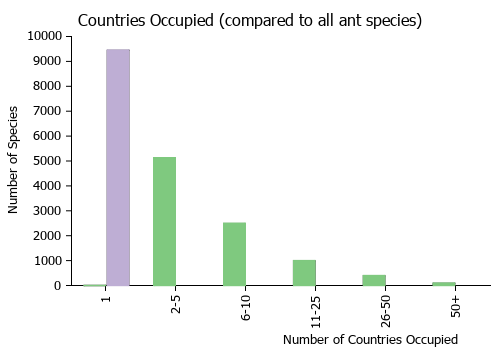Leptogenys reggae
| Leptogenys reggae | |
|---|---|

| |
| Scientific classification | |
| Kingdom: | Animalia |
| Phylum: | Arthropoda |
| Class: | Insecta |
| Order: | Hymenoptera |
| Family: | Formicidae |
| Subfamily: | Ponerinae |
| Tribe: | Ponerini |
| Genus: | Leptogenys |
| Species group: | antillana |
| Species: | L. reggae |
| Binomial name | |
| Leptogenys reggae Lattke, 2011 | |
Known from a single specimen. This species may be another Caribbean endemic or even exclusive to Jamaica.
Identification
Lattke (2011) - A member of the antillana species group. Median clypeal lobe broad, apex bluntly rounded with 3 median setae, lateral margins lamellate; compound eye broadly convex, flattened, its length just under one-third that of lateral cephalic margin, eye laterally placed in cephalic mid-distance; mandible elongate, basal and external margins parallel; petiole subtriangular in lateral view, anterodorsal margin convex, node highest posterad with bluntly pointed apex.
Keys including this Species
Distribution
Distribution based on Regional Taxon Lists
Neotropical Region: Jamaica (type locality).
Distribution based on AntMaps
Distribution based on AntWeb specimens
Check data from AntWeb
Countries Occupied
| Number of countries occupied by this species based on AntWiki Regional Taxon Lists. In general, fewer countries occupied indicates a narrower range, while more countries indicates a more widespread species. |

|
Estimated Abundance
| Relative abundance based on number of AntMaps records per species (this species within the purple bar). Fewer records (to the left) indicates a less abundant/encountered species while more records (to the right) indicates more abundant/encountered species. |

|
Biology
|
Castes
Queens and males are unknown.
Nomenclature
The following information is derived from Barry Bolton's Online Catalogue of the Ants of the World.
- reggae. Leptogenys reggae Lattke, 2011: 146, fig. 5 (w.) JAMAICA.
Unless otherwise noted the text for the remainder of this section is reported from the publication that includes the original description.
Description
Worker
Metrics, holotype: HL 1.18; HW 0.80; ML 0.60; EL 0.26; SL 1.14; PW 0.66; WL 1.76; PH 0.70; PL 0.56; DPW 0.38 mm. CI 0.68; MI 0.75; OI 0.33; SI 1.43; LPI 1.25; DPI 0.68.
Head subrectangular in full-face view, slightly wider anterad than posterad, posterior and lateral margins broadly convex; median clypeal lobe broad, apex bluntly rounded with 3 median setae, lateral margins lamellate; lateral clypeal lobe lamellate, little expanded. Compound eye broadly convex, flattened, its length just under one-third that of lateral cephalic margin, eye laterally placed in cephalic mid-distance; mandible elongate, basal and external margins parallel, basal margin convex, basal tooth developed as distinct denticle, masticatory margin edentate, concave; dorsal surface with fine parallel striae basad, sparse punctae throughout, apicad smoother. Cephalic dorsum mostly smooth and shining, with scattered piligerous punctulae which become more dispersed posterad; clypeus smooth with some longitudinal to oblique striae. Scape surpasses posterior cephalic border by one-fourth its length; third antennal segment just under 2 x longer than second segment, 3 x longer than apical width. Scape mostly smooth and shining, with piligerous punctulae which become dense apicad.
Mesosoma with promesonotum forming single broad convexity in lateral view, metanotal groove deeply impressed, dorsal propodeal margin broadly convex, twice longer than declivitous margin; propodeal margin straight, unarmed, without lobe or denticle. Pronotum mostly smooth and shining with sparse piligerous punctae; propleuron smooth and shining, mesopleuron with rugulae on anepisternum and posteroventrad, weakly colliculate medially; metapleuron with rugulae anterad, medially mostly smooth and shining with rugulae along metapleural-propodeal suture, and transversely striate posteroventrad. Mesonotum and propodeal dorsum smooth and shining, propodeal spiracle broadly oval, facing posterad; mesonotum oval shaped, slightly wider than long; metanotal groove smooth; propodeal declivity subtriangular, wider posterad than anterad with transverse striae. Mesometapleural suture well impressed; metapleural-propodeal suture partially impressed as series of rugulae that extend mid-distance between propodeal and mesothoracic spiracles.
Petiole subtriangular in lateral view, anterodorsal margin convex, node highest posterad with bluntly pointed apex, posterior margin inclined, with strong convexity basad; node triangular in dorsal view, lateral margin concave, width of anterior margin less than half width of posterior margin, anterior margin convex, posterior margin weakly convex. Subpetiolar process shaped as posteroventrally bent rectangle, with ventral denticle. Node mostly smooth and shining with some rugulae anteroventrad, cross-section of node at mid-length V-shaped. Anterior margin of third abdominal segment mostly straight and posteriorly inclined, dorsal margin mostly straight with posterior convexity; constriction between abdominal segments III and IV well developed; gaster smooth and shining with sparse piligerous punctulae. Coxae and rest of legs mostly smooth and shining, protibia sparsely punctulate, meso- and metatibia with abundant punctulae, especially apicad; mesotibial apex with single external seta, pro- and metatibia without setae; body with sparse subdecumbent to erect hairs, no appressed pubescence. Mandible, antenna, apex of median clypeal lobe, legs, and gastral ferruginous brown; rest of body dark brown.
Type Material
Holotype worker. Jamaica, Saint Ann, 2.5 mi S. Moneague, 700 m, 3.iii.1968, S. Peck & A. Fiske. Deposited in Museum of Comparative Zoology.
Etymology
The species name alludes to the musical genre associated with Jamaica, and Saint Ann Parish in particular, the birth place of famous reggae musicians such as Bob Marley and Burning Spear.
References
References based on Global Ant Biodiversity Informatics
- Lattke J. E. 2011. Revision of the New World species of the genus Leptogenys Roger (Insecta: Hymenoptera: Formicidae: Ponerinae). Arthropod Systematics and Phylogeny 69: 127-264

